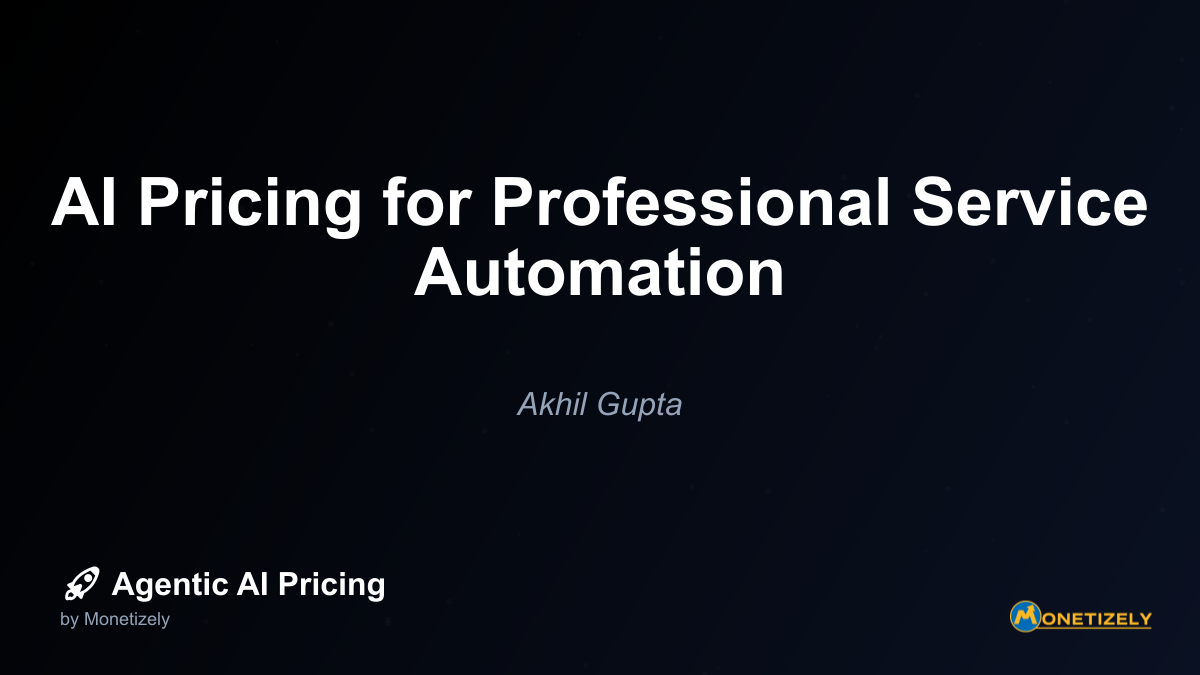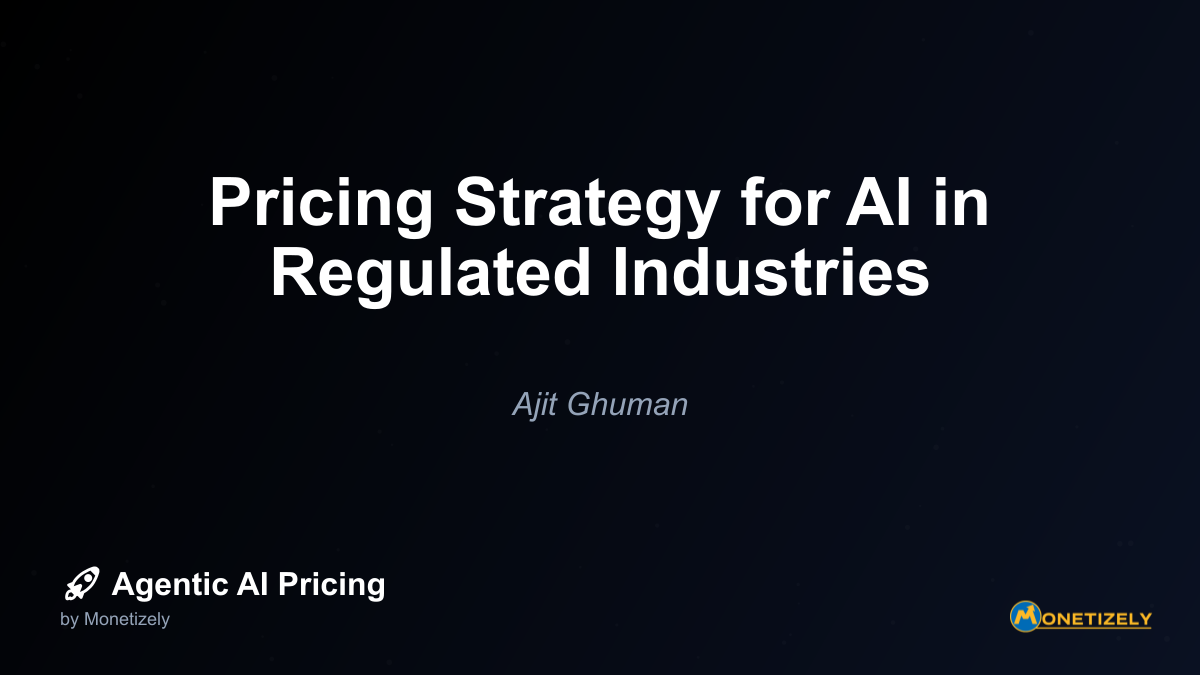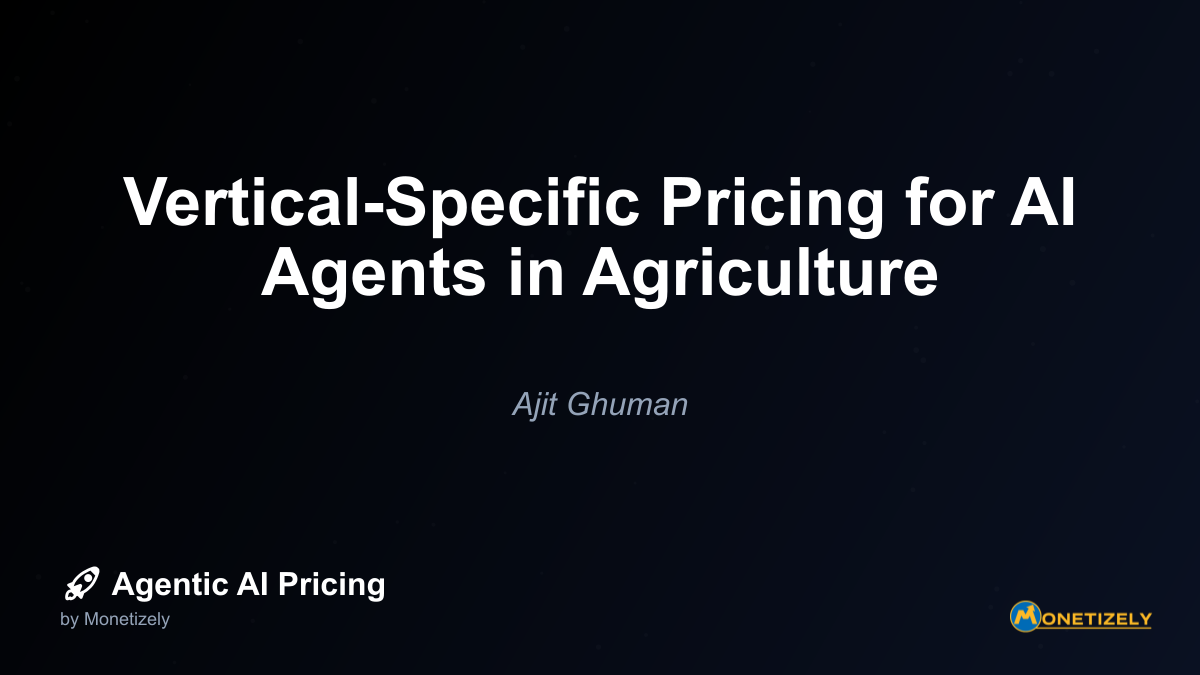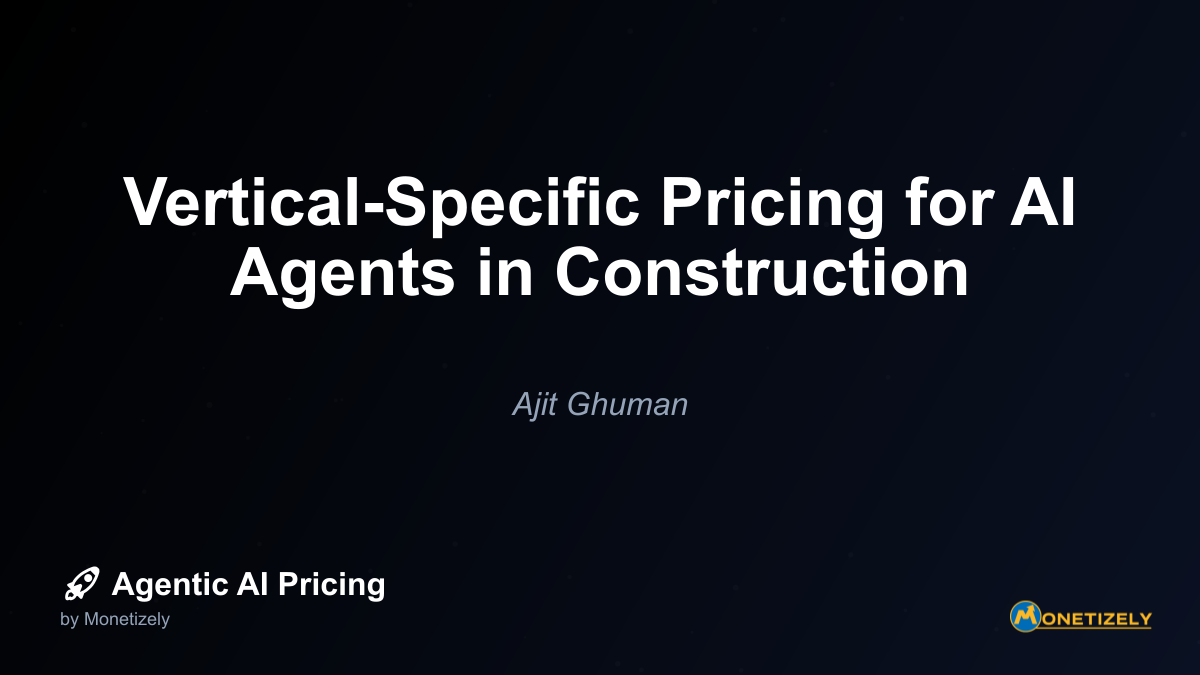· Ajit Ghuman · Industry-Specific · 12 min read
Vertical-Specific Pricing for AI Agents in Research and Development
AI and SaaS Pricing Masterclass
Learn the art of strategic pricing directly from industry experts. Our comprehensive course provides frameworks and methodologies for optimizing your pricing strategy in the evolving AI landscape. Earn a professional certification that can be imported directly to your LinkedIn profile.
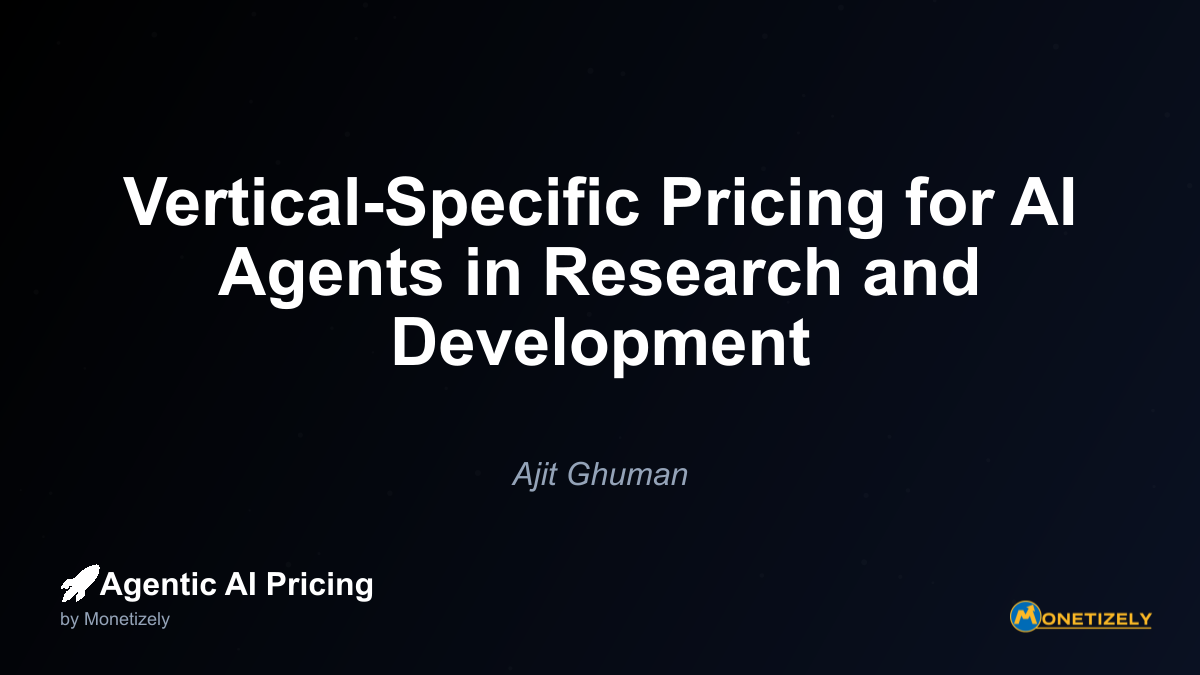
In the rapidly evolving landscape of artificial intelligence, pricing strategies for vertical-specific AI agents in research and development (R&D) present unique challenges and opportunities. The intersection of cutting-edge technology and specialized research domains requires thoughtful pricing approaches that balance innovation incentives with sustainable business models. This is particularly evident in fields like pharmaceutical research, materials science, and academic research settings where AI agents are transforming hypothesis generation and experimental design.
The Current Landscape of R&D AI Agent Pricing
The global AI agent market reached approximately $7.63 billion in 2025 and is projected to grow at a compound annual growth rate (CAGR) of around 45%, potentially reaching $47.1 billion by 2030. This explosive growth reflects the increasing adoption of AI agents across various industries, with R&D applications representing a significant portion of this expansion.
Traditional pricing models for software and technology services have proven inadequate for the unique value proposition of AI agents in research settings. While consumption-based pricing (paying for compute time or API calls) remains common, it often fails to align with the true value created when an AI agent accelerates a scientific breakthrough or optimizes an experimental protocol.
The Shift from Consumption to Value-Based Pricing
Recent market data indicates a significant shift away from traditional seat-based pricing models toward more sophisticated approaches:
- Seat-based pricing in AI dropped from 21% to 15% of companies between 2024 and 2025
- Hybrid and usage/outcome-based models surged from 27% to 41% during the same period
- Companies using per-seat models experience 40% lower gross margins and over double the churn rate compared to those with more flexible pricing
This transition reflects the recognition that AI’s value in research contexts extends far beyond mere usage metrics. As one pricing executive at a major AI research platform noted, “When your AI agent helps discover a molecule that becomes a blockbuster drug, charging by the API call seems almost comically disconnected from the value created.”
Vertical-Specific Pricing Considerations in R&D
Different research domains present distinct challenges and opportunities for AI agent pricing strategies. Let’s examine the unique considerations across three major verticals:
Pharmaceutical and Biotech R&D
The pharmaceutical industry has embraced AI agents for drug discovery, clinical trial optimization, and hypothesis generation. Pricing strategies in this vertical have evolved to address the long timelines, high risks, and potentially enormous rewards characteristic of pharmaceutical R&D.
Dominant Pricing Models
Subscription-Based Models: Annual license fees ranging from $500,000 to several million dollars, with tiered access and volume-based pricing for compute resources. While straightforward, this approach doesn’t align incentives around project success.
Milestone-Based Pricing: Payments linked to research milestones such as target validation or lead identification. This better aligns provider incentives with R&D outcomes but may not fully account for project timelines.
Royalty and Revenue-Share Models: Smaller upfront fees with a percentage (typically 1-5%) of product revenues once developed. This aligns long-term incentives between AI provider and company but delays provider returns until commercial success.
Hybrid Models: Combining elements of subscription, milestone, and royalty approaches to balance risk and reward. For example, a base subscription fee plus milestone payments and smaller revenue share percentages.
Case Study: BioAI Solutions
BioAI Solutions, a leading provider of AI agents for pharmaceutical research, implemented a hybrid pricing model with three tiers:
- Discovery Tier: $750,000 annual subscription with unlimited access to basic hypothesis generation and literature analysis capabilities
- Development Tier: $1.5 million annual subscription plus 2% milestone payments at preclinical, Phase I, and Phase II stages
- Enterprise Tier: $2.5 million annual subscription plus 1% royalty on approved therapies discovered using the platform
After implementing this model, BioAI reported 30% revenue growth and 95% reduction in client campaign analysis costs, demonstrating the effectiveness of aligning pricing with both short-term value and long-term outcomes.
Special Considerations for Pharma AI Pricing
- Regulatory Compliance: Pricing must account for validation and documentation requirements in regulated environments
- Data Integration Complexity: The value of AI increases with access to proprietary research data, requiring pricing models that incentivize data sharing
- Long Development Timelines: Models must balance immediate revenue needs with the reality that full value realization may take 5-10+ years
Materials Science Research
Materials science research presents different challenges and opportunities for AI agent pricing. The field focuses on designing and discovering new materials with specific properties, often requiring extensive computational simulation and experimental validation.
Dominant Pricing Models
Compute-Based Pricing: Charges based on computational resources consumed, reflecting the intensive simulation requirements of materials science AI
Discovery-Based Pricing: Fees tied to successful identification of materials with specified properties, creating alignment between AI provider and researcher goals
License Plus Services: Core platform licensing combined with consulting services for implementation and customization
Case Study: MaterialsAI
MaterialsAI, a specialized platform for computational materials discovery, implemented a tiered pricing structure:
- Academic: $50,000 annual license with limited compute resources
- Commercial Research: $250,000 annual license with expanded compute allocation
- Enterprise: $750,000 annual license with unlimited compute and custom model development
The company reported that commercial clients achieved average time-to-discovery reductions of 47% compared to traditional methods, justifying the premium pricing through quantifiable efficiency gains.
Special Considerations for Materials Science AI Pricing
- Compute Intensity: Materials simulations often require significant computational resources, making resource-based pricing components essential
- IP Ownership: Clear delineation of intellectual property rights for discovered materials must be reflected in pricing structures
- Academic-Industrial Collaboration: Pricing models must accommodate both academic budgets and commercial research requirements
Academic Research Settings
Academic research environments present unique pricing challenges due to budget constraints, diverse research goals, and the emphasis on open science principles.
Dominant Pricing Models
Tiered Academic Pricing: Significantly discounted rates compared to commercial applications, often scaled by institution size or research volume
Grant-Aligned Pricing: Structures designed to align with typical grant funding cycles and budgets
Freemium Models: Basic capabilities offered free of charge, with premium features available for subscription fees
Consortium Pricing: Shared access models where multiple institutions collectively fund AI agent development and access
Case Study: ScienceAI Collective
The ScienceAI Collective, a consortium of AI providers serving academic research, implemented a novel pricing approach:
- Free access to basic hypothesis generation tools for all researchers
- Institutional subscriptions ($75,000-$250,000 annually) based on size and research volume
- Specialized module access priced according to computational requirements
- Optional success fees for commercialized discoveries (typically 0.5-1%)
This model has enabled access for over 500 research institutions while maintaining sustainable operations through a combination of institutional subscriptions and commercialization fees.
Special Considerations for Academic AI Pricing
- Budget Constraints: Academic research operates under tight budgetary limitations, requiring creative pricing approaches
- Open Science Values: Tension between commercial sustainability and academic norms of openness and sharing
- Educational Component: Pricing may include training and educational elements to build capability and adoption
Balancing Success Rates and Research Timelines
A critical factor in pricing AI agents for R&D is understanding the relationship between success rates, research timelines, and perceived value. This is particularly evident in pharmaceutical research, where success rates at various development stages directly impact the economic value of AI assistance.
The Impact of Success Rate Improvements
Consider the typical pharmaceutical development process:
- Target identification to lead compound: ~10% success rate
- Preclinical to Phase I: ~60% success rate
- Phase I to approved drug: ~10% success rate
- Overall success rate (target to approved drug): ~0.6%
AI agents that improve success rates at any stage create enormous value. For example, an AI agent that improves the target-to-lead success rate from 10% to 15% effectively increases the overall probability of success by 50%. This translates to significant economic value that should be reflected in pricing.
As noted in Pricing AI in Drug Discovery: Balancing Success Rates and Research Timelines, “The value of an AI agent that improves success probability by even a few percentage points can justify premium pricing when the potential reward is measured in billions.”
Timeline Acceleration Value
Beyond improving success rates, AI agents create substantial value by accelerating research timelines. In pharmaceutical development, where each day of patent protection for an approved drug can represent millions in revenue, acceleration creates quantifiable value.
For example, if an AI agent reduces discovery time by six months for a potential blockbuster drug with $1 billion in annual sales, it creates approximately $500 million in additional lifetime revenue through extended effective patent life. This timeline acceleration value should be a key factor in pricing models.
Implementation Challenges and ROI Measurement
Organizations implementing AI agents for R&D face several common challenges that impact pricing decisions and perceived value:
Technical Integration Complexity
Integration with existing research workflows and systems often requires significant customization and technical support. Pricing models must account for this implementation complexity while remaining competitive.
According to PwC’s AI Agent Survey, organizations face hurdles related to “integration complexity, governance, and interoperability, especially in regulated industries requiring traceability and compliance.” These implementation challenges directly impact the total cost of ownership beyond the base AI agent pricing.
ROI Measurement Challenges
Measuring return on investment for R&D AI agents presents unique challenges:
Long Feedback Loops: The time between AI implementation and measurable research outcomes can span months or years
Attribution Complexity: Determining the specific contribution of AI to research success versus other factors
Opportunity Cost Assessment: Evaluating not just what was discovered but what would have been missed without AI assistance
Successful pricing models address these measurement challenges by incorporating clear ROI frameworks and metrics tailored to the specific research context. For pharmaceutical applications, these might include:
- Reduction in time-to-candidate identification
- Improvement in candidate quality metrics
- Decrease in failed experimental paths
- Acceleration of regulatory submission preparation
Emerging Pricing Trends and Future Directions
The pricing landscape for R&D AI agents continues to evolve rapidly. Several emerging trends will likely shape future pricing strategies:
1. Multi-Agent Ecosystems and Bundle Pricing
As organizations deploy multiple specialized AI agents across their research workflows, pricing models are evolving to accommodate ecosystem approaches rather than individual agent licensing. Bundle pricing and enterprise-wide access models are becoming more common, providing cost efficiencies for organizations with diverse research needs.
2. Dynamic Pricing Based on AI Capability Evolution
AI agents are continuously improving through both algorithmic advances and expanded training data. Future pricing models will likely incorporate dynamic elements that adjust pricing based on demonstrated capability improvements, creating incentives for ongoing AI enhancement.
3. Ethical and Responsible AI Premiums
As concerns about AI ethics, bias, and transparency grow, pricing models may incorporate premiums for AI agents with superior governance, explainability, and ethical frameworks. This is particularly important in research settings where decisions must be defensible and transparent.
4. Consortium and Shared Risk Models
For high-risk, high-reward research areas, consortium models where multiple organizations share the cost and risk of AI agent development are emerging. These approaches distribute both the investment burden and the potential returns across participants.
5. Quantum Computing Integration
As quantum computing becomes more accessible, AI agents leveraging quantum capabilities for complex research simulations will command premium pricing reflecting their enhanced performance. This is particularly relevant for materials science and pharmaceutical research involving complex molecular modeling.
Strategic Recommendations for Pricing Decision-Makers
For organizations developing or deploying AI agents in R&D settings, several strategic considerations should guide pricing decisions:
For AI Agent Providers:
Align Pricing with Value Creation: Structure pricing to reflect the specific value created in each research vertical rather than generic technology metrics
Incorporate Outcome Components: Include elements tied to research outcomes to align incentives and demonstrate confidence in AI capabilities
Develop Vertical-Specific ROI Frameworks: Create clear methodologies for measuring and demonstrating return on investment tailored to each research domain
Balance Accessibility and Premium Value: Structure tiered offerings that provide entry points for budget-constrained organizations while capturing appropriate value from enterprise deployments
Consider the Full Customer Journey: Pricing should evolve alongside the customer’s growing sophistication and expanding use cases
For Research Organizations:
Evaluate Total Value Potential: Look beyond immediate cost to assess the full potential value across research portfolios
Negotiate Aligned Incentives: Seek pricing structures that align AI provider success with research outcomes
Build Internal Valuation Capabilities: Develop frameworks for assessing AI agent contributions to research success
Consider Portfolio Approaches: Distribute AI investment across multiple projects to balance risk and maximize potential returns
Invest in Complementary Capabilities: Ensure organizational readiness to maximize AI agent value through data quality, workflow integration, and staff training
Case Study: Vertical-Specific Pricing in Action
Pharmaceutical R&D: MoleculeAI
MoleculeAI provides AI agents specifically designed for drug discovery and development. Their pricing model evolved through three distinct phases:
Phase 1 (2022-2023): Simple subscription model
- $1 million annual license
- Unlimited users
- Standard support package
- Result: High initial adoption but disconnection between pricing and value created
Phase 2 (2023-2024): Tiered subscription model
- Basic tier: $500,000 annually for hypothesis generation
- Advanced tier: $1.2 million annually for hypothesis generation and lead optimization
- Premium tier: $2 million annually for full platform access
- Result: Better alignment with customer needs but still disconnected from outcomes
Phase 3 (2024-present): Hybrid value-based model
- Base platform license: $300,000-$800,000 annually depending on organization size
- Success fees: $250,000 per compound advancing to preclinical development
- Milestone payments: 1-3% of milestone payments received for successful candidates
- Royalty component: 0.5% of net sales for approved therapies
- Result: 40% increase in customer retention and 65% growth in total contract value
This evolution demonstrates the industry trend toward aligning pricing with specific research outcomes and value creation rather than technology access alone.
Materials Science: QuantumMaterials
QuantumMaterials specializes in AI-driven materials discovery using quantum computing techniques. Their innovative pricing approach includes:
- Base platform access: $350,000 annually
- Compute credits: Usage-based pricing for quantum computing resources
- Success fees: $100,000-$500,000 for materials meeting specified performance criteria
- IP structure: Customers retain full IP rights to discovered materials with no royalty obligations
This model balances the high fixed costs of quantum computing infrastructure with the uncertain but potentially enormous value of novel materials discovery. By charging success fees rather than royalties, QuantumMaterials removes long-term IP encumbrances while still capturing value from successful discoveries.
Conclusion: The Future of Vertical-Specific R&D AI Agent Pricing
As AI agents become increasingly sophisticated and integral to research and development across verticals, pricing strategies must evolve to reflect their true value contribution. The most successful approaches will:
- Align incentives between AI providers and research organizations
- Reflect the unique value drivers of each research vertical
- Balance immediate revenue needs with long-term value capture
- Incorporate both usage and outcome elements
- Adapt to the evolving capabilities of AI technology
Organizations that master these principles will be well-positioned to navigate the complex landscape of R&D AI agent pricing, creating sustainable business models that accelerate scientific discovery and technological innovation.
The transition from generic, consumption-based pricing to sophisticated, vertical-specific models represents not just a business strategy evolution but a fundamental shift in how we value AI’s contribution to human knowledge and progress. As one pharmaceutical executive noted, “When your AI helps discover a treatment that changes patients’ lives, the value created transcends traditional pricing metrics. The right pricing model acknowledges this while creating sustainable economics for continued innovation.”
In the rapidly evolving landscape of AI-powered research and development, thoughtful pricing strategies that recognize the unique characteristics of each vertical will be essential to unlocking the full potential of this transformative technology.
Co-Founder & CEO
Ajit is the author of Price To Scale, a top book on SaaS Pricing and is the Founder of Monetizely. Ajit has led and worked in pricing and product marketing at firms like Twilio, Narvar and Medallia. His work has been featured in Forbes and VentureBeat. Ajit regularly consults with software companies from Seed stage to post-IPO on pricing strategy. Ajit is also a highly-rated co-instructor for 'The Art of SaaS Pricing and Monetization' on Maven.
Pricing Strategy Audit
Let our experts analyze your current pricing strategy and identify opportunities for improvement. Our data-driven assessment will help you unlock untapped revenue potential and optimize your AI pricing approach.

